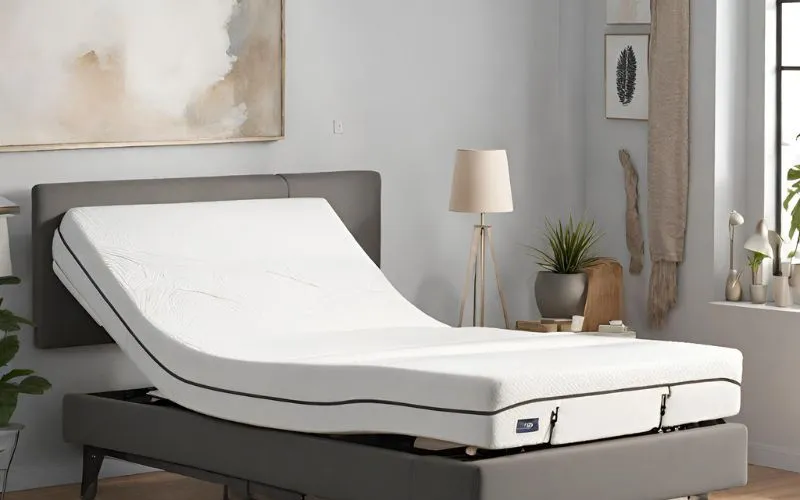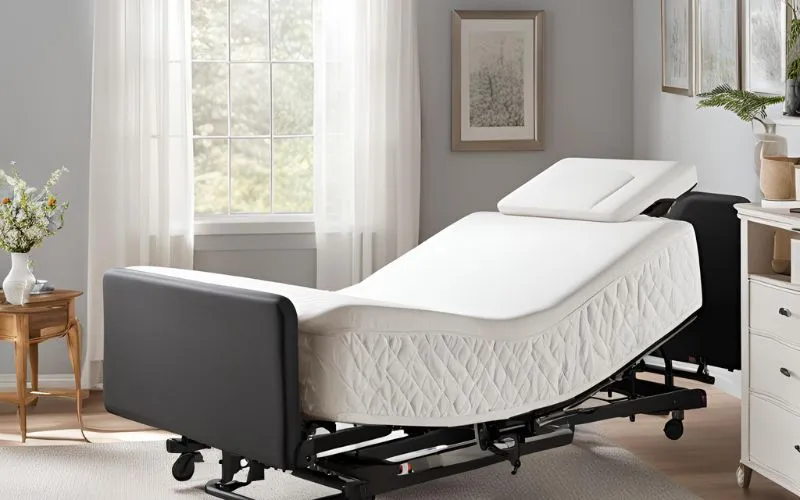The Science Behind How Adjustable Beds Improve Sleep

Introduction
Adjustable beds have revolutionized the way people sleep, offering a customizable and comfortable solution to various sleep-related issues.
While traditional beds limit the ability to adjust the angle and elevation, adjustable beds provide the flexibility to cater to individual comfort and support needs. In this comprehensive guide, we explore the science behind adjustable beds and their impact on sleep improvement.
Understanding Adjustable Beds and Sleep Improvement
What are Adjustable Beds?
Adjustable beds, also known as power bases or electric beds, are designed with multi-hinged lying surfaces that can be adjusted to different positions. This adaptability allows users to elevate the head, foot, or other sections of the bed to achieve the most comfortable sleeping posture.
- Enhanced Comfort: Adjustable beds provide personalized comfort by allowing users to find the perfect position for relaxation and sleep. They can alleviate common discomforts such as back pain, acid reflux, and snoring.
- Health Benefits: The versatility of adjustable beds supports various health benefits, including improved circulation, reduced inflammation, and enhanced breathing during sleep.
- Convenience: With adjustable beds, users can easily adjust the inclination of the bed with a simple touch of a button, providing convenience and flexibility for daily activities such as reading, watching TV, or working on a laptop while in bed.
The Science of Sleep and Its Impact on Health
Sleep is not just a state of rest, but a complex and dynamic process that is essential for overall health and well-being. Let’s dive deeper into the science of sleep and unravel its impact on our physical and mental well-being.
- Non-Rapid Eye Movement (NREM): This stage consists of four distinct stages, each with its unique characteristics. NREM sleep is when the body repairs and regenerates tissues, builds bone and muscle, and strengthens the immune system.
- Rapid Eye Movement (REM): During REM sleep, the brain is highly active, and this is the stage where most dreaming occurs. REM sleep is crucial for cognitive function, memory consolidation, and emotional regulation.
Understanding these stages is fundamental to comprehending the intricacies of sleep and its impact on our daily lives.
Quality sleep goes beyond feeling refreshed in the morning. It has a profound impact on mental clarity, emotional balance, and physical health. When we consistently experience restful and restorative sleep, our cognitive function, mood regulation, and overall well-being improve significantly.
Adjustable beds have been designed with the science of sleep in mind. By enabling individuals to customize their sleep positions, these beds can contribute to improved sleep quality and overall health. Understanding the relationship between sleep science and adjustable beds provides insights into how they can positively impact our sleep patterns.
Effects of Adjustable Beds on Sleep Quality
Positional Benefits of Adjustable Beds
Adjustable beds offer a range of positional benefits that contribute to better sleep quality and overall comfort. By providing customizable positioning options, these beds can alleviate various common sleep-related issues and enhance overall wellbeing.
- Reduction of Snoring: Elevating the head and torso can significantly reduce snoring by opening up the airways and improving breathing patterns. This can lead to a quieter and more restful night’s sleep for both the individual and their sleep partner.
- Relief from Acid Reflux: A raised sleeping position helps minimize acid reflux symptoms by preventing stomach acid from flowing back into the esophagus. This can alleviate discomfort and support better digestion, particularly after meals.
- Enhanced Circulation: Adjustable beds can promote improved blood circulation by allowing individuals to elevate their legs and reduce pressure on veins. This can be particularly beneficial for individuals with circulation-related issues or those who spend long hours sitting or standing during the day.
- Reduced Swelling: Elevating the legs can help reduce swelling, especially in the lower extremities, providing relief for individuals with conditions such as edema or lymphedema. This can contribute to more comfortable and less restless sleep.
By offering these versatile and personalized positions, adjustable beds play a crucial role in addressing a variety of common sleep disturbances and physical discomforts, ultimately contributing to an improved sleep experience and overall well-being.
Improvement in Breathing and Blood Circulation
Adjustable beds offer significant benefits for breathing and blood circulation, contributing to overall health and well-being. The optimal positioning of the bed can have a profound impact on respiratory function and blood flow, particularly for individuals with sleep apnea, asthma, or other respiratory issues. Let’s delve into the detailed benefits:
- Enhanced Breathing: When the bed is adjusted to elevate the upper body, it can alleviate breathing difficulties by opening up the airways. This position is especially beneficial for individuals with sleep apnea, as it reduces the obstruction of the air passages, allowing for improved airflow during sleep.
- Improved Blood Circulation: By raising the legs or adjusting the bed to a zero-gravity position, better blood circulation is facilitated. This promotes relaxation, reduces stress on the heart, and enhances sleep quality. Additionally, it can alleviate symptoms of conditions such as edema and varicose veins.
- Relief for Respiratory Issues:The adjustable features of the bed provide customizable support to help individuals with asthma or other respiratory conditions find a comfortable sleeping position that eases breathing and promotes better rest.
- Prevention of Snoring: Elevating the head of the bed can help prevent snoring by keeping airways open, which in turn contributes to a more restful sleep for both the individual and their partner.
Reduction of Pain and Discomfort
Adjustable beds offer relief from pain and discomfort by allowing users to find a comfortable sleeping position that minimizes pressure on the body. This reduction in pressure points can be beneficial for those suffering from back pain, arthritis, or other musculoskeletal conditions.
Impact on Sleep Disorders
Impact on Sleep Disorders
Adjustable beds have a significant impact on sleep disorders, offering tailored solutions for individuals with conditions such as insomnia, sleep apnea, and restless leg syndrome.
- Insomnia: For those experiencing insomnia, adjustable beds provide the flexibility to elevate the head and legs, promoting a more comfortable sleeping position and potentially reducing the symptoms of restlessness.
- Sleep Apnea: The positional adjustments available with adjustable beds can aid in minimizing the impact of sleep apnea by elevating the upper body, thereby reducing airway obstruction and improving breathing during sleep.
- Restless Leg Syndrome: Individuals with restless leg syndrome may benefit from the customizable positioning options of adjustable beds, helping to alleviate discomfort and involuntary leg movements, ultimately leading to a more restful sleep experience.
Furthermore, the ability to personalize the support and positioning of an adjustable bed can contribute to the management of sleep disorders. By providing the option to elevate the upper body and legs, individuals can find relief from symptoms, experience improved comfort, and establish healthier sleep patterns.
Factors to Consider When Choosing an Adjustable Bed for Sleep Improvement
Features to Look for in Adjustable Beds
When selecting an adjustable bed for sleep improvement, it’s essential to consider several important features that can significantly enhance the overall sleeping experience. These features cater to individual preferences and ensure maximum comfort and functionality. Let’s explore the key features to look for in adjustable beds:
- Programmable Positioning: A high-quality adjustable bed should offer programmable positioning, allowing users to customize their sleep and resting positions according to their individual comfort levels. This feature provides personalized support and helps alleviate pressure points, resulting in a more restful sleep.
- Massage Functions: Many adjustable beds come equipped with massage functions that offer gentle vibrations to relax the body and promote better circulation. These massage features can be adjusted to different intensities and target specific areas, providing soothing relief to muscles and aiding in relaxation.
- Remote Controls: Easy-to-use remote controls are an essential feature of adjustable beds, allowing users to effortlessly adjust the bed’s positioning, activate massage functions, and customize settings without the need to manually reposition the bed. Intuitive remote controls contribute to a seamless and convenient sleep experience.
- Compatibility with Mattresses: It’s crucial to ensure that the chosen adjustable bed is compatible with various types of mattresses, including memory foam, latex, and hybrid mattresses. This compatibility ensures that users can fully benefit from the features of the adjustable bed while enjoying the support and comfort of their preferred mattress.
Matching Adjustable Beds with Individual Sleep Needs
When it comes to matching adjustable beds with individual sleep needs, there are several crucial factors to consider. Understanding and addressing these factors can significantly enhance sleep quality and overall comfort. Here are the key considerations:
- Firmness Preferences: Individuals have varying preferences for mattress firmness. Adjustable beds should cater to these preferences, offering options for different firmness levels to accommodate diverse needs.
- Sleeping Positions: Different sleeping positions require different support and alignment. Whether someone sleeps on their back, stomach, or side, the adjustable bed should provide the necessary adjustments to promote proper spinal alignment and alleviate pressure points.
- Health Conditions: Existing health conditions, such as arthritis, GERD, or sleep apnea, can greatly impact sleep quality. Adjustable beds equipped with specific features, such as inclination settings or elevation capabilities, can provide relief and improve overall comfort for individuals with these conditions.
It’s important to note that each person’s sleep requirements are unique, and adjustable beds should be able to adapt to these individual needs. By considering firmness preferences, sleeping positions, and health conditions, the right adjustable bed can be chosen to optimize comfort and support for a restful night’s sleep.
Conclusion
Adjustable beds offer a myriad of benefits for sleep improvement, addressing individual comfort, support, and health needs. Understanding the science behind sleep and the positive effects of adjustable beds on sleep quality is key to making an informed decision when considering sleep improvement solutions.




